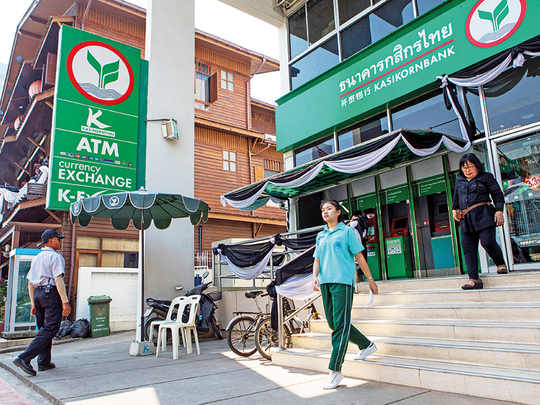
BANGKOK: As one of four presidents at Thailand’s biggest lender, Kasikornbank, Kattiya Indaravijaya often conducts interviews for senior positions. The job candidates are impressive. And almost always, they’re women.
“I’m wondering, there’s no guy?” Kattiya, 51, said in an interview in her office along the Chao Phraya River in Bangkok. “It’s not that they didn’t pass the screening process, they didn’t apply. Perhaps women’s interest is in banking and finance. Perhaps guys have a different passion.”
In Thailand, where years of educational equality have combined with a profession that rewards math skills and merit, women comprise 31 per cent of board and executive committee members in financial services — some way short of parity but the highest proportion in the world after Norway and Sweden, according to a study last year by consulting firm Oliver Wyman. In the US, the representation of women in similar positions is 20 per cent. Japan is at the bottom of the list, with 2 per cent.
“Men probably look for more exciting and challenging jobs than the financial industry, where work requires more patience, detail, caution and rule compliance,” said Voravan Tarapoom, president of the Association of Investment Management Companies, a mutual funds trade group, and also chairman of BBL Asset Management Co. “They may feel financial industry work is so boring.”
BBL has to pay special attention to the number of males hired, or else women will dominate the firm, Voravan said.
“Financial jobs require very detailed and cautious persons,” she said. “This may fit the female character more.”
Women account for 57 per cent of Thailand’s finance and insurance workforce, according to government statistics. Yet the fact that two-thirds of senior management and executive roles are filled by men indicates Thai women still face challenges in achieving equality, said Joni Simpson, a specialist on gender, equality and non-discrimination at the International Labour Organisation in Bangkok.
“Accounting is a field that is accessible to women in Thailand, and therefore they have been able to advance in this sector and are highly visible across several levels of jobs,” she said, citing cultural norms and attitudes in Thailand. “The chances are better for women to advance to the highest levels.”
Yet across all industries, Thai women account for less than 10 per cent of executive and management roles on average, she said. More work needs to be done in all sectors including finance to encourage mentoring, access to childcare and eldercare, and chances for advancement, she said.
Still, Thailand’s high proportion of women in senior financial roles happened without government legislation, said Bandid Nijathaworn, chief executive officer at the Thai Institute of Directors and a former deputy governor of the Bank of Thailand. Norway and Sweden, like other countries in Europe and elsewhere, have enacted laws requiring companies to have 30 per cent of their boards comprised of women.
The Thai central bank has had a female governor, from 2006 to 2010, and at least half of its managerial staff is female. At the Stock Exchange of Thailand, the president is female, as are almost 70 per cent of workers. Thailand has also had a female prime minister, Yingluck Shinawatra, the sister of the ruler deposed in a 2006 coup.
“Female executives must show much more superior or outstanding managerial skills and competency over male colleagues to receive promotions,” said Kesara Manchusree, the president of the Stock Exchange of Thailand. “It’s a very tough job to balance business and family roles.”
Across the Asia-Pacific region, the proportion of women in senior business roles has climbed to 25 per cent this year from 23 per cent in early 2016, according to a global survey released Wednesday by consultancy Grant Thornton. At the same time, the percentage of Asian companies with no female representation in senior management surged to 36 per cent from 25 per cent in the same period last year.
At Kasikornbank, Kattiya remembers a male-dominated organisation when she joined about three decades ago, after her father suggested banking as a career rather than her initial choice of advertising.
Kasikornbank had almost no female employees until around 1984, according to Chatchai Payuhanaveechai, who worked there for about three decades, including as a senior executive vice president. He’s now president of the state-owned Government Savings Bank.
“Even at my bank, when we open up new positions, about 80 per cent of applications have been from female candidates — this is the trend in Thai banking,” he said. “I think the new male generation wants to be entrepreneurial. We’re now in a reversal where we’ve been promoting the hiring of male employees.”
Female employees in finance and insurance numbered 314,300 in the third quarter of 2016, according to the latest government data. For men, the number is 244,400.
Today at Kasikornbank, the 14,000 female employees outnumber men 2-to-1. The bank outperforms its peers: 2016 return on equity was 13 per cent compared with the 11 per cent average of Thai lenders, according to data compiled by Bloomberg.
As its first female president, Kattiya focuses on finance, human resources and integration across departments. With an MBA from the University of Texas at Austin, she’s one of two women on the bank’s 26-strong management team, according to the bank’s website — and was an unusual presence at a large dinner with Vietnamese Prime Minister Nguyen Xuan Phuc at the World Economic Forum annual meeting in Davos in January.
“I was the only woman,” she said, showing a picture on her mobile phone. “There must have been at least 30 people — business people from Russia, Japan and Thailand. So it’s still a male dominated world. Women are playing major roles in the business world, but there is still more to come.”


